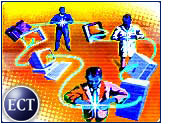
The worlds of e-commerce and online advertising are going through a bit of a phase, it seems.
Experimentation is the name of the game, as e-tailers and others try to break free of “old” formulas in an all-out effort to re-stoke the growth engines that hummed so powerfully for a while.
The problem is what two of these recent experiments have in common: They are intrusive. They are in-your-face. And they are annoying.
The two innovations, if we can call them that, are the X10.com pop-under advertising campaign and the Half.com “Price Patrol.” Both foreshadow a much less user-friendly Web experience in the not-too-distant future.
Who Left the Windows Open?
The X10.com story is an interesting one. In what one analyst called an online “carpet bombing,” X10.com bought advertising space on the Web’s busiest sites, enabling the company to, uninvited, open extra browser windows containing a link to the X10.com’s home page. The X10 browser windows open under the browser window the Web user already had open, and whether or not the user clicks on the ad window, X10.com counts the user as part of its Web traffic.
In addition to millions of page views, the tactic has gotten X10.com some free press, which is probably more valuable than the ineffective pop-under ads themselves. Add it all up and you get what advertising industry spin doctors would call a broader palate for advertising online.
Great, except this particular part of the palate happens to involve my computer. Hijacking my browser for X10.com’s gain might have gotten the company coverage in the trade press. It might even win X10.com a few new customers. But it sure isn’t going to make any friends.
Volunteers Unite
Half.com’s experiment which is intended to keep its customers from straying is slightly less annoying because it’s voluntary. The company emphasizes this point, of course, as it should. In order to get the “Price Patrol” plug-in, you or I have to download it first.
But once that threshold is crossed, “Price Patrol” is always on duty, advising what’s for sale at Half.com. That could get intrusive in a hurry.
Given the confluence of content and e-commerce, I foresee plenty of instances when I might not even be shopping and yet, here comes the Half.com patrol, popping up another browser window to tap me on the shoulder like a Times Square watch salesman.
Just Browsing, Thanks
The most frightening part of the Half.com experiment is that it makes sense and very well might work.
If so, success will only lead to escalation. Half.com’s plug-in takes less than a minute to download. The next one will take 30 seconds. Then 10. And then a site will offer to do it for you, just click here.
It’s bound to happen, especially if it works well.
Personal Property?
Yes, this is all part of the maturation process for the Web. It’s not pretty to watch experiments in progress. And it’s even less fun to be one of the little white mice running through the maze.
The problem is that consumers aren’t likely to fight back against having their browsers usurped or their surfing time constantly interrupted with commercial reminders. That lack of outcry or action will be taken as tacit approval and the spiral will go around again.
And then one morning, we’ll wake up and find the Internet not only isn’t the place it used to be, but isn’t even a place we want to go anymore at all.
What do you think? Let’s talk about it. ![]()
Note: The opinions expressed by our columnists are their own and do not necessarily reflect the views of the E-Commerce Times or its management.
















































It is difficult to say, but somehow visitors will have to pay for all the free information they are getting. Portals that give away information for free have to survive, for that they have to charge in some way the visitors. One of the possibilities is doing advertisement, this is a cost for all of us, more weight (time downloading the site) and intrusive information that I didn’t ask for. We don’t pay with cash but with discomfort.
It is important that Portals stay alive and they have to do their best efforts to make it. They tried better methods, but hasn’t worked ($). The solution goes by doing context advertisement, that way the costs of weight and intrusive information get compensated by the value of the contextual ad information the portal gives me.
Let’s progress on applications that administrate ads in a more contextual way!
Regards
Rodrigo Edwards M.
E-Agency
http://www.vmanagers.net
The advertising on the Web has become so annoying that there are many sites I no longer visit (CNN, most of Yahoo, etc.).
I long ago did the simple things you can do via browser Preferences (turn off GIF animation, disbale plug-ins, etc.) to limit ad annoyance , jsut short of turning off graphics altogether. I’ve also looked into various ad-deleting solutions, but by shutting off animation and plugins (to kill Flash-based ads and their ilk), one could make most sites tolerable.
Now, with “skyscrapers” and “4-by-4s” more screen space is covered with ads that I *never* click on. The pop-under/over ads are also quite annoying and the advertisers have to be fools to think that people aren’t going to immediately click the close box!
I have no problem paying for ad-free content. I think new media firms are missing the mark here re: subscriptions. You could have three levels of subscription: (1) free content with lots of ads, (2) low cost subscription with very few ads, (3) higher-cost subscription with NO ads.
Advertising in the US has become a blight on the population — it’s gone too far in the real world and will quickly go too far in the cyberworld. I fight back against companies whose advertising I find too intrusive by simply not buying their products!
Ads are annoying, but they are the price of admission to the theme park known as the Internet. There are some websites that simply have no ads or very few, but these websites are the exception. We better get used to ads, intrusive or otherwise, if we wish to freely access the content of our favorite websites. It’s a shame that the option of subscribing to a website in exchange for the removal of these ads does not exist for most websites. Even if that option did exist, though, would many people take advantage of it? What price would you pay to see your favorite website ad-free?
Internet Content Subscription models do not work. I have been in the internet business since 1985. Remember Genie? CompuServ? Delphi? All subscription-based content providers and all no longer with us, they were ISPs too. Online newspapers are killing subscription-based internet sections, San Jose Merc, Chicago Trib and others because no one pays for a subscription. ESPN.com had a premium content subscription area…Gone…lack of interest and $ubscription$.
I for one love contextual Ads on a page of content. Ad Banners, Sweet Spots, 4x4s are all great if they target me with things I have a interest in.
These pop-unders are just plain wrong. What if a television advertiser turned your TV on after you just turned it off every time you finished watching? (TIVO, AOLTV, WebTV just might be able to do this). What if you turned your radio off in the car to listen to your CD and a radio advertiser made you listen to an Ad first before the CD played? What if your wireless PDA forced you to see an Ad before every time you check your email even if you were paying for wireless service? What if your ATM forced you to watch a 30-second commercial about home loans before it spit out your cash?
These Ad intrusions will not stop until the consumer pushes back and says “That’s enough”. The author is correct when he says that if consumers don’t respond it is a tacit signal of acceptance and there will be no limit.
Instead of coming up with thousands of useless ways of blanketing ad messages, Advertisers should develop intelligent ad delivery and targeting. Here’s a thought, work with the content providers to come up with intelligent/contextual ad targeting.
Unfortunately, the vast majority of Internet publishers who tried to charge for content, were unsuccessful.
How much would you be willing to pay a good site each month?
$2.95?
$29.99?
49.99?
Think about it.
I just turn off JavaScript in my browser and ads do not pop; I do not have to put up with any of this barbra streisand. In fact, until I used someone else’s computer, I had been totally oblivious about these new ads. Now, I AM AM used at how mad they make people, knowing I AM missing out on all of the “fun.”
Those X10 ads are one of the most annoying things I’ve ever seen. I’ve already emailed the company that I will never buy anything from them because of the ads. If more people will do that, maybe we can stop pop-up or pop-over or whatever they’re called ads before they start.